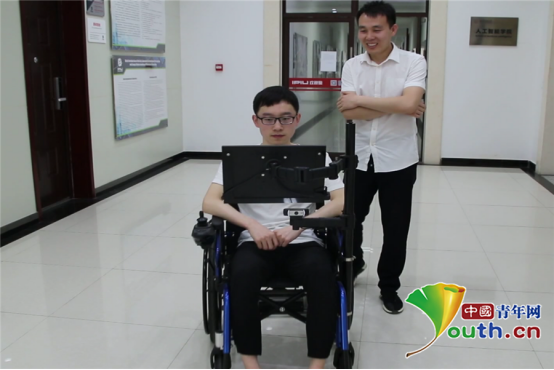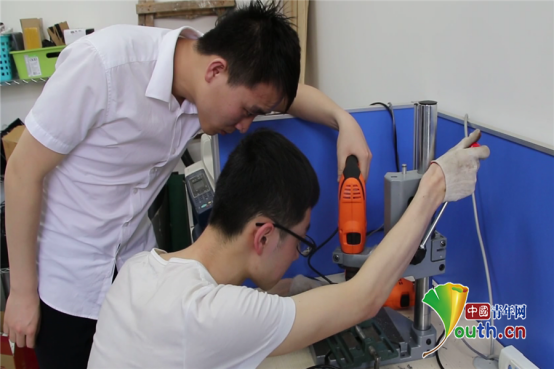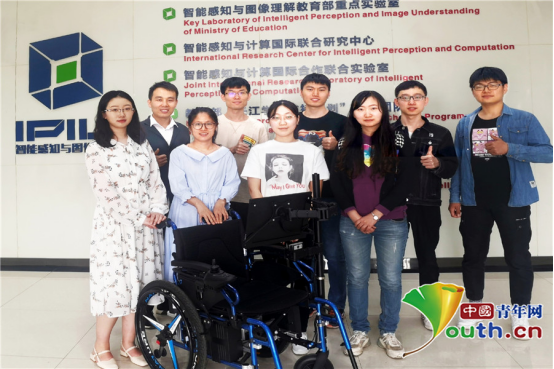Eye control! West Power Student Making Intelligent Wheelchair for Freezing Patients
When Zhang Wei, a frozen patient, sat in a wheelchair specially designed for him free of charge to achieve eye control, her mother on the other side shed tears of joy and gratitude.
This wheelchair is made by students of the College of Artificial Intelligence of Xi'an University of Electronic Science and Technology under the guidance of Professor Jiao Li Chenghe and Dr. Sun Qigong. It has been accumulated in three years and combined with Zhang's personal needs. In addition to overcoming technical difficulties, wheelchairs involve details that cannot be illustrated with drawings, all of which are made by students themselves. Despite the difficulties encountered in the production process, the students felt "very happy" when they saw that their knowledge and efforts could help the patients with cryopreservation.

Dr. Sun Qigong (right) and Sun Long of Xi'an University of Electronic Science and Technology demonstrate intelligent wheelchairs.
Eye control wheelchair cryopreservation patients to achieve free movement
On April 19, the reporter met the intelligent wheelchair made by students in Xi'an University of Electronic Science and Technology. From the appearance, the wheelchair which can help the patients move freely is composed of a host, a motion controller, a sensor, a screen and a wheelchair body. The frozen patient sits on it and can control the wheelchair's direction by looking at the screen with his eyes. In other words, when the patient looks forward, the wheelchair will move forward.
Sun Qigong introduced that the intelligent wheelchair, with the help of computer vision technology and artificial intelligence means, can realize the function of analyzing patients'eye intentions. In terms of safety, wheelchairs can be forced to stop when the patient's eyes are drifting to ensure safety. At the same time, the wheelchair also combines smart home functions to control lighting, air conditioning, television and other household equipment.
At present, Zhang Wei has been using an intelligent wheelchair for more than a month. According to Zhang's actual situation, the wheelchair has increased the table, added seat belts, and added folding functions. "Zhang Wei likes music, we also specially installed a music player for the wheelchair." Sun Qigong said. With this wheelchair, Zhang Wei gradually realized the daily life of self-care, no longer need to live with his mother.

Dr. Sun Qigong (left) and Sun Long of Xi'an University of Electronic Science and Technology work in the laboratory.
Research and Development of Intelligent Wheelchair for Middle School Students
Speaking of the birth of this intelligent wheelchair, it still goes back to 2017. At that time, a businessman from Zhejiang Province came to Xi'an University of Electronic Science and Technology, hoping to customize an intelligent wheelchair to support patients with cryopreservation. When Sun Qigong heard about it, he thought it was a good thing. He often helped Jiao Licheng, the teacher, guide his students and sisters. He decided to lead them to do it together. He said: "There are many technical barriers to break through, students can learn a lot of technical points when they do, but also can solve the actual needs, help the patients with cryopreservation."
In the 17 graduate students just enrolled, a project team was quickly formed. The team used two months of summer vacation to make the first generation of intelligent wheelchairs, but this is only a prototype, which can not meet the needs of use. After one year's technical accumulation, in the summer of 2018, a new team was born among the 18 graduate students, and the research and development of the second generation intelligent wheelchair was completed.
"The second generation wheelchair fully considers the actual situation of patients, and spends a lot of effort on functional design and safety assurance to ensure the daily use and safe travel of patients. But there are also some drawbacks, such as the structure is not light enough, so we continue to improve, forming the current third generation wheelchair. Sun Qigong said.
It is also from the 17th Graduate Entrance, the College of Artificial Intelligence of Xi'an University of Electronic Science and Technology has formed different project teams. Graduate students choose different projects to join according to their interests, so as to consolidate their knowledge in this practical way and realize their learning to be useful. In the laboratory, the reporter also saw another project besides the intelligent wheelchair, an intelligent game robot, which is still under development and is also manufactured by the student team.
It's a great pride to help others with what you have learned.
Since 2017, the smart wheelchair of Xi'an University of Electronic Science and Technology has completed three generations of changes, and the project team has become more and more powerful, even with the participation of undergraduates. At present, in addition to Sun Qigong, the team also includes four doctoral students, three master's students and one senior. During the interview, the reporter met Sun Long, one of the members, who is in the first year of Ph.D. He told reporters that because we still have a lot of courses and homework to complete, we can only make smart wheelchairs in our spare time.

Group photo of Intelligent Wheelchair Project of Xi'an University of Electronic Science and Technology.
"When we decide to make this wheelchair Zhang Wei, there will be a sense of time urgency, because the life of the patients with cryopreservation is limited, we can do it today or tomorrow." Sun Long said. So, when the progress can not reach the expected time is when everyone feels very frustrated, but there are many things on the hardware that can not be expected, such as the whole circuit suddenly failed, it needs to start checking again.
Sun Long told reporters: "We spend nearly 10 hours a day in the laboratory, sometimes sleeping in the laboratory to solve a problem. I remember very clearly that once in the corridor debugging wheelchair until more than 11:40 p.m., there was a very young girl who left the laboratory with everyone after the debugging was completed. Everybody's working hard for this.
It's worth all the hard work to see Zhang Wei, a frozen patient, in his wheelchair. In Sun Long's words, "It's a very proud thing to be able to help people who are in trouble with what you have learned." Now, the team meets Zhang Wei every other week or two to help him further debug and improve the wheelchair function. Sun Qigong said that next step, they will develop output functions for wheelchairs to help people with cryopreservation express their feelings. That is to say, the story of intelligent wheelchairs and cryopreservation is not over yet.
From the network